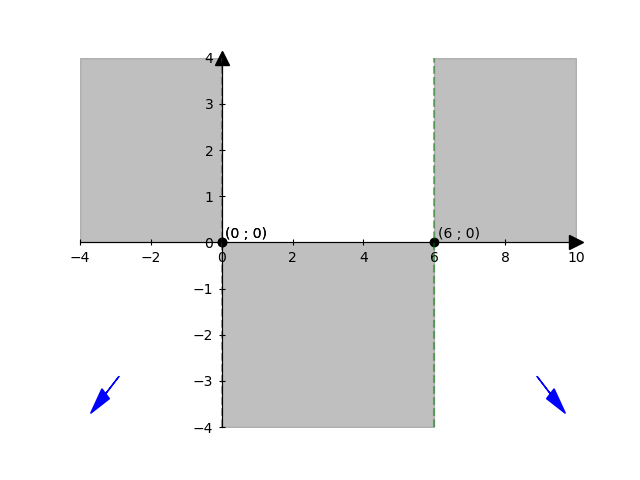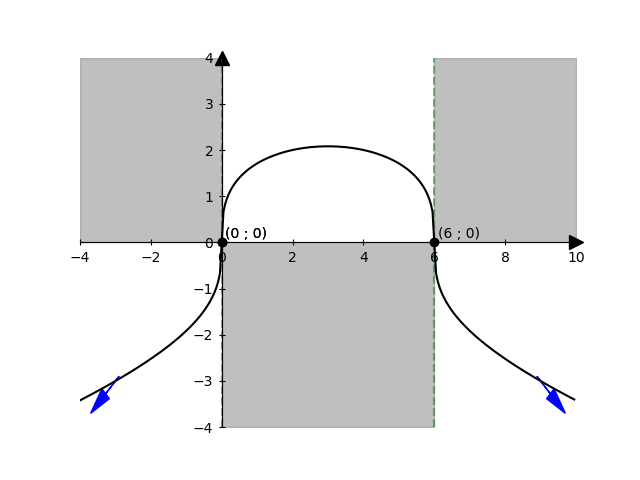Studio di funzione
Funzione con radicali
\(\displaystyle y= \sqrt[3]{ 6x - x^2 } \)
Non ci sono condizioni che limitano il dominio, perciò:
\(\forall x \in \mathbb{R}\)
\(f(-x) = \sqrt[3]{ 6(-x) - (-x)^2 } = \sqrt[3]{ -6x -x^2 } \neq f(x)\) perciò non è pari
\(-f(-x) = - \sqrt[3]{ 6(-x) - (-x)^2 } = \sqrt[3]{ 6x + x^2 } \neq f(x)\) perciò non è dispari
Intersezioni con l'asse x (zeri):
\( \left\{ \begin{array}{l} y = 0 \\ y= \sqrt[3]{ 6x - x^2 } \end{array} \right. \)
Da cui
\(y= \sqrt[3]{ 6x - x^2 } = 0\)
\(6x - x^2 = 0\)
\(x \left( 6 - x \right) = 0\)
Prima soluzione: \(x = 0\)
Seconda soluzione \(6 - x = 0\) da cui \(x = 6\)
Intersezioni asse x: \(( 0 ; 0 )\) e \(( 6 ; 0 )\)
Intersezioni con l'asse y:
\( \left\{ \begin{array}{l} x = 0 \\ y= \sqrt[3]{ 6x - x^2 } \end{array} \right. \)
Da cui
\(y(0) = \sqrt[3]{ 6(0) - (0)x^2 } = 0\)
Intersezione con asse y: \(( 0 ; 0 )\)

\(y \gt 0\) quindi \(\sqrt[3]{ 6x - x^2 } \gt 0\)
\(6x - x^2 \gt 0\)
\(x \gt 0\)
\(x \lt 6\)
0 6
--------|+++++++|+++++++
++++++++|+++++++|-------
- | + | -
\(\displaystyle \lim_{ x \to - \infty} { \sqrt[3]{ 6x - x^2 } } = - \infty \)
Possibile asintoto obliquo
\(\displaystyle m_1 = \lim_{ x \to - \infty} { { f(x) } \over x } = \)
\(\displaystyle = \lim_{ x \to - \infty} { { \sqrt[3]{ 6x - x^2 } } \over x } = \left[ {- \infty } \over {- \infty } \right] = \)
Applicando de l'Hopital:
\(\displaystyle = \lim_{ x \to - \infty} { {1 \over 3} { { 6 - 2x } \over { \sqrt[3]{ \left( 6x - x^2 \right) ^2 } } } \cdot { 1 \over 1} } = \left[ { \infty } \over {\infty } \right] = \)
E fattorizzando \(x\) a numeratore e denominatore:
\(\displaystyle = \lim_{ x \to - \infty} { {1 \over 3} { { x \left( { 6 \over x } - 2 \right) } \over { x^{4 / 3} \sqrt[3]{ \left( {6 \over x} - 1 \right) ^ 2 } } } } = \)
\(\displaystyle = \lim_{ x \to - \infty} { {1 \over 3} { { \left( { 6 \over x } - 2 \right) } \over { x^{ 1 / 3} \sqrt[3]{ \left( {6 \over x} - 1 \right) ^ 2 } } } } = { { -2 } \over { - \infty } } = 0 \)
Per avere asisntoto obliquo \(m_1 \ne 0\), pertanto non c'è asintoto obliquio sinistro e non è necessario calcolare:
\(\displaystyle q_1 = \lim_{ x \to - \infty} { { f(x) } - m_1 x } \)
\(\displaystyle \lim_{ x \to + \infty} { \sqrt[3]{ 6x - x^2 } } = { \sqrt[3]{ \left[ \infty - \infty \right] } } = \)
\(\displaystyle = \lim_{ x \to + \infty} { \sqrt[3]{ x^2 \left( {6 \over x} - 1 \right) } } = - \infty \)
Possibile asintoto obliquo
\(\displaystyle m_2 = \lim_{ x \to + \infty} { { f(x) } \over x } = \)
\(\displaystyle = \lim_{ x \to + \infty} { { \sqrt[3]{ 6x - x^2 } } \over x } = \left[ {+ \infty } \over {+ \infty } \right] = \)
Con passaggi analoghi al caso precedente si ha che:
\(\displaystyle = \lim_{ x \to + \infty} { {1 \over 3} { { \left( { 6 \over x } - 2 \right) } \over { x^{ 1 / 3} \sqrt[3]{ \left( {6 \over x} - 1 \right) ^ 2 } } } } = { { -2 } \over { + \infty } } = 0 \)
Per avere asisntoto obliquo \(m_2 \ne 0\), pertanto non c'è asintoto obliquio destro e non è necessario calcolare:
\(\displaystyle q_2 = \lim_{ x \to + \infty} { { f(x) } - m_2 x } \)

\(\displaystyle y'= { { 1 \over 3 } {1 \over { \left( 6x - x^2 \right) ^{2/3} } } \left( 6 - 2 x \right) } = { { 6 - 2x } \over { 3 \sqrt[3]{ \left( 6x - x^2 \right) ^2 } } } \)
\(\displaystyle \left\{ \begin{array}{l} y' = 0 \\ y'= { { 6 - 2x } \over { 3 \sqrt[3]{ \left( 6x - x^2 \right) ^2 } } } \end{array} \right. \)
Da cui
\({ { 6 - 2x } \over { 3 \sqrt[3]{ \left( 6x - x^2 \right) ^2 } } } = 0\)
\({ 6 - 2x } = 0\)
\(x = 3\)
\(y' \gt 0\) quindi \({ { 6 - 2x } \over { 3 \sqrt[3]{ \left( 6x - x^2 \right) ^2 } } } \gt 0\)
Bisogna studiare due termini separatamente e combinare insieme i segni:
\(6 - 2x \gt 0\) \(\Rightarrow x \lt 3\)
\(3 \sqrt[3]{ \left( 6x - x^2 \right) ^2 } \gt 0\) \(\Rightarrow \forall x \neq \pm 3\)
-3 3
+++++++|+++++++|-------
+++++++o+++++++o+++++++
+ | + | -
Cres. Cres. Dec.
\( y''= - {1 \over 3} { { 2 \left( 6x-2 x^2 \right) ^3 + { 2 \over 3 } \left( 6 -2 x \right) ^2 } \over { \left( 6x - 2 x ^2 \right)^5 } } \)
TODO
\( \left\{ \begin{array}{l} y'' = 0 \\ y''= - 9 { { \sqrt{ x^2 -9 } } \over { \left( x^2 -9 \right)^2 } } \end{array} \right. \)
Da cui
\(- 9 { { \sqrt{ x^2 -9 } } \over { \left( x^2 -9 \right)^2 } } = 0\)
\(\sqrt{ x^2 -9 } = 0\) \(\Rightarrow x = \pm 3\)
Per \(x = \pm 3\) si hanno inversioni di concavità, ma tali punti sono anche estremi del dominio e quindi non sono flessi
\(y'' \gt 0\) quindi \(- 9 { { \sqrt{ x^2 -9 } } \over { \left( x^2 -9 \right)^2 } } \gt 0\)
Bisogna studiare il segno dei termini separatamente e combinarli insieme:
\(- 9 \gt 0\) \(\Rightarrow \nexists x \in \mathbb{R}\)
\(\sqrt{ x^2 -9 } \gt 0\) \(\Rightarrow x \neq \pm 3\)
\(\left( x^2 -9 \right)^2 \gt 0\) \(\Rightarrow x \neq \pm 3\)
-3 0 3
--------|-------|-------|-------
++++++++o+++++++|+++++++o+++++++
++++++++o+++++++|+++++++o+++++++
- | | | -
Down Down
